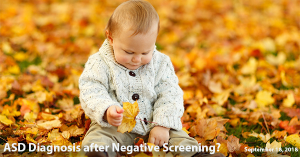Archives
September, 2018
Select a different month in the archive
Traits of Kids Diagnosed with ASD after Passing M-CHAT
By Chelsea Toledo, M.A. on September 18, 2018

Background: Diagnosis of ASD requires systematic and structured observation of a child by trained clinicians. While the diagnostic process is comprehensive, the first step is a screening – known as the Modified Checklist for Autism in Toddlers (M-CHAT) – that takes place at children’s regular pediatric appointments when they are 18 months old.
What’s New: A recent study focused on children whose M-CHAT screenings were negative, but who later received ASD diagnoses. The researchers examined data from more than 68,000 children collected as part of the Norwegian Mother and Child Cohort Study to look for children who passed the screening at 18 months but later received a diagnosis of ASD.
The researchers found:
- 228 of the children who screened negative ultimately received ASD diagnoses, constituting “false negatives.”
- Both boys and girls in the false negative group were rated as less social, less communicative, and having diminished gross motor skills compared to their counterparts in the true negative group. These effects were larger among girls, who constituted 16 percent of false negatives.
- Boys and girls in the false negative group were also shown to have diminished fine motor skills and to be less sociable than their counterparts in the true negative group.
- While boys in the false negative group were more shy than boys in the true negative group, the opposite was true of girls.
- No difference was found between the false and true negative groups in terms of emotionality and activity.
Why it’s important: This is the first study to establish a profile of “false negatives” for the M-CHAT screening. Future research
Help me understand :
| Source(s) : |
| Tweet |
Research Needed on Resources for Young Adults with ASD
By Chelsea Toledo, M.A. on September 11, 2018

Background: Most research done to date on Autism Spectrum Disorder (ASD) has focused on individual factors and outcomes, such as the genetic basis for ASD or the effects of treatment on individuals. However, less academic attention has been given to people with ASD as a population – such as studies of the non-clinical interventions that may affect outcomes for this group.
What’s New: A recent article outlined a new research agenda, prioritizing topics for those studying ASD in the United States. These priorities stemmed from key informant interviews as well as a meeting of stakeholders representing the medical, therapeutic, educational, policy, and public health fields. Both of these processes were informed by a scoping review identifying gaps in existing research on ASD and the transition of youth into adulthood.
The stakeholders identified three main priorities for research targeting youth with ASD:
- Studies describing the existing landscape of services and programs for people with ASD, including its availability and adaptability to individual needs;
- Studies on the coordination of ASD stakeholders, including adults with ASD, their family members, and mental health organizations; and
- Studies on the quality of life of people with ASD and how it varies among people, groups, and populations.
Why it’s important: This article sets out knowledge gaps in the existing research on ASD and provides a path forward for researchers interested in helping this population. The authors also emphasize the need for increased involvement of people with ASD in informing priorities and moving the research agenda forward.
Help me understand :
| Source(s) : |
| Tweet |

